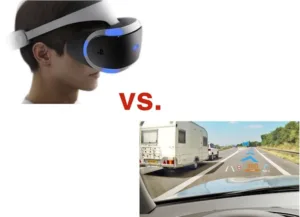When Google Glass was announced, the idea was more about what we could do with this technology rather than what we can use this technology for. As a consequence Google announced an explorer program with the hope that a user would stumble upon a killer application.

They even paid some celebrities to sport the headset during events to gain more market exposure. Needless to say, none of it prevented the shutdown of Google Glass as a consumer device
Following the shutdown of the consumer program, the Google AR headset followed the lead of many other headset makers in addressing industrial and business applications. In subsequent announcements the high value of AR for many scientific, industrial, business, etc. applications has been publicized. Time and money savings took the place of the sexiness the Google Glass Explorer program was after, or to be more technical the AR headset was being rationalized. Was this the end of AR for consumers?<
During the last year Apple, Samsung and other brands have talked about the importance of AR and have all made great efforts to position themselves as providers of AR in the future. As it turns out, so far all companies have focused on software solutions for AR and not on hardware development of a headset. The typical article on tech blogs starting with ‘Apple works on headset…’ means we are sure that Apple has some engineers working on this kind of thing and we have no clue if, and when, they will release such a product.<
While the importance of AR software tools seems to be acknowledged by everyone, what we can do with such apps is not so clear. Thinking of the success of Pokemon Go, many thought that games would be the application driving this technology, but until now this has also been a one hit wonder. There is an argument to be made that for Pokemon Go the attraction for kids and adults alike was the massive multiplayer aspect rather than the small AR aspect of Pokemons running over the table. In any case, you needed to watch the AR world through the keyhole of your smartphone rather than through a massive headset that can bring the AR world to your attention.
However you want to look at it, the field of view is very limited (that goes for smartphones as well as headsets) and does not make it very easy to use augmented reality in our everyday lives. Meanwhile, the marketing people and development companies focused a great deal of effort on inventing new names for AR and telling us how this new name “will change everything”. So far, it works as well as Google Glass did.
Let us focus more on the reality aspects than just words to see where this technology could lead.
When we use AR, we combine some computer generated content in form of words, graphs, images, etc. with the real world to create additional value to the scene we are seeing. For example, when we call a person on the phone, AR would add this person to the real world to better connect us with the person (the next version of video calls), or we walk down the street looking for our friend and the AR shows us where he is (nav programs already do this just without the AR component). You can think of every number of activities where such AR functionality could be useful. The question is whether, if it still requires AR glasses, people would use them?
The one activity where such a functionality would be very useful, and is under development with some market success, is in cars. The head up display is basically an AR device. Forget about the different terms for a moment and focus on what the system is doing for the driver. It adds some information on speed and directions into the viewing field of the driver and, as such, augments the real world view with augmented reality. The question that many bring up is where the information is displayed? Current HUD systems just show them in front of the driver at the end of the car’s hood. When we add eye tracking to such a system we can know in which direction the driver is looking. When we add cameras to the mix, we also know what the driver is looking at. Combine them all together and we can show in what lane they should be driving and where the entry to the parking garage is exactly. Now that would be helpful, wouldn’t you agree?
Companies were talking about such technology as the second or third generations of HUDs, some also called them AR HUD. This was several years ago. Stilll no HUD system in the market can provide this functionality, today. It requires some more technology integration and improvements in several areas to achieve such a promised result. Here is the positive side of this application; there is no power limitation, the user does not need to wear a headset, and last, but not least, you do not need to make this all so small that it fits a pair of sunglasses. These are all some pretty hefty limitations that AR headset developers are fighting with today.
Altogether, my money is on the car as the first major consumer device to incorporate AR functionality in a substantial way. Headsets will remain an industrial, business, medical, educational, etc, device where the advantages outweighs the form factor until the technology had time to be ready for consumer prime time or until the consumer is ready for the headset. NH

